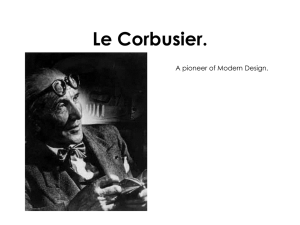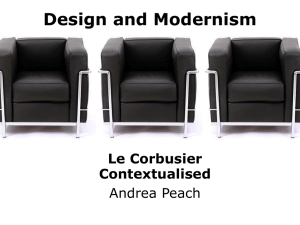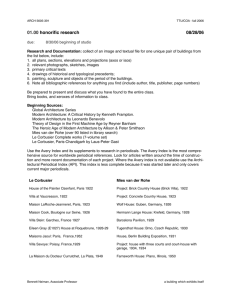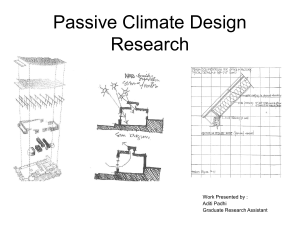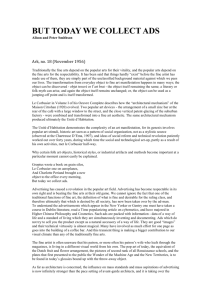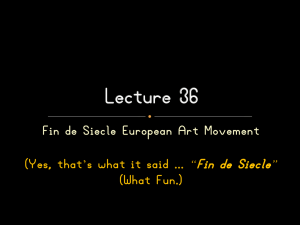Document
advertisement
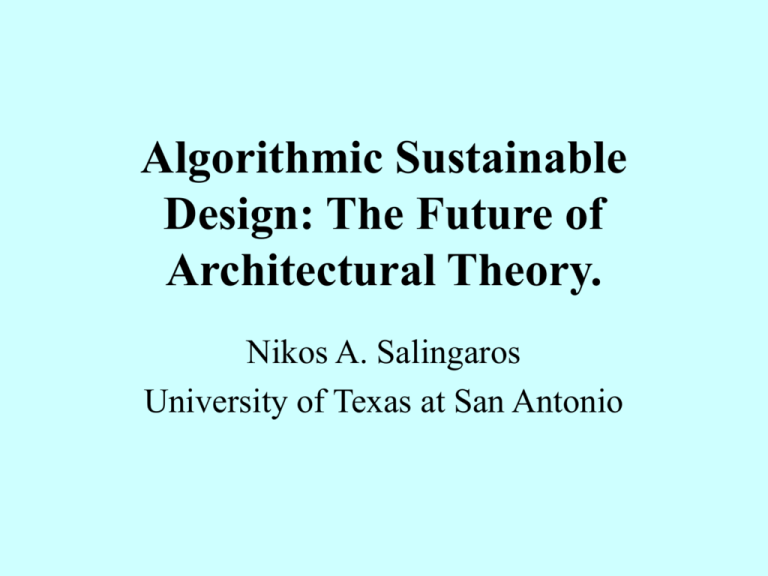
Algorithmic Sustainable Design: The Future of Architectural Theory. Nikos A. Salingaros University of Texas at San Antonio Lecture 8 A. Emergent systems. B. Examples from artificial life. C. Inhuman experiments. D. Architectural education. Preamble • Notice that current architectural education and practice are opposite to the method presented in my lectures • But established system is not integral with natural and biological systems • If we want sustainability, my lectures provide the most helpful direction A. Emergent systems • I now apply systems theory to explain some phenomena of human society • Systems develop new characteristics not present in the initial inputs — an instance of emergence • A system of beliefs grows over time, and eventually takes over a society • Social contagion spreads a new norm Power as an emergent phenomenon • Ideology and questionable beliefs lead to the emergence of a power structure • System grows in strength and detaches itself from the rest of the world • Becomes more and more insular • Periodic “reform” perpetuates power structure — a staged deception George Orwell’s novel “1984” • The past is erased — people are forced to live in the present • Power is expressed by inflicting pain • Reality is defined only by the system • There is no other truth to turn towards • Totalitarian system re-writes history A “new” tradition emerges • Movement based on ideas turns into an institutional power base • Irrational ideas are transformed into established (rational!) practice • Henceforth, the system’s goal is simply to perpetuate the existing power structure by any available means Educational system ignores biophilia and adaptivity • System of architectural education concentrates upon abstract forms • Style-based design is detached from biological needs and from nature • Design is detached from spiritual needs • There is no integrity with humanity Main goals for architectural education • Should be to raise people’s awareness of the effects of the built environment • To take responsibility for one’s designs • To focus on wellbeing of inhabitants • Not only to come up with novel shapes • Not to become mindless pawns of a manipulative power system B. Artificial life • Innocent aspect: pixels on a computer screen move around and gobble each other up — only a game • Alarming aspect: the two-way transformation between living beings and machines — extremely serious • This latter process has re-shaped humanity in the 20th Century Relationship between machines and living beings • Two possible ways to go: • 1. UP — make machines mimic capabilities of living beings • 2. DOWN — reduce living beings to the characteristics of machines • Going DOWN determines the form of the 20th Century’s built environment From living being to machine Going UP — enhance machines • Computers enhance our capabilities • Great successes in robotics: Rodney Brooks’ Mars Explorer • Industrial robots can work in delicate, dangerous, or repetitive conditions • Military robots save lives — more expendable than humans Going UP (cont.) • Add more and more intelligent qualities to machines, so that they are able to mimic human capabilities • Increase their perceptive mechanisms • Increase their capacity to process information • Increase autonomous action capability Going DOWN — reduce beings • Advertising brainwashes people (Le Corbusier was an advertising pioneer!) • Manipulate people as inert entities • Transforms human beings into mechanical consumers of industrial products • Brainwash humans to act as suicide bombers — expendable beings Going DOWN (cont.) • Remove more and more intelligent qualities from humans, until they begin to act like machines • Decrease perceptive mechanisms • Decrease capacity for processing information • Decrease autonomous action capability Industrialization of animals • Beings become an industrial product • Battery-raised chickens pass all their lives crammed together in atrocious conditions • Bred with growth hormones and genetically modified — made into unnatural monsters • Laboratory animals used in cruel and inhumane experiments Industrialization of people • Mass production driven by speed, volume, efficiency, cost, bottom line • Uses workers as machines, or as simple cogs in a production machine • Reduces the complex humanity of people to a single mechanistic function Contemporary trends • French-Canadian philosopher and author Ollivier Dyens explores the merging of humans with machines • — in his book “Metal and Flesh”, MIT Press, Cambridge, 2001 • Major trend underlying all our culture • More DOWN than UP “Metal and Flesh” Artificial life • Was achieved in the 20th Century • — opposite of what was expected! • — not the elevation of machines to the level of humans, or even animals • Instead, the reduction of animals and human beings to the level of machines Social engineering • Creates monsters from living beings • Manipulates their genetic information to create unnatural new forms of life • Seeks to fundamentally re-shape life forms so that they benefit industrial production and consumption • Aims to fit life into a machine world Three levels of being human • • • • 3. The transcendent human being 2. The biological human being 1. The abstract (mechanical) human being Most complete, most fulfilling existence moves through all three levels • Contemporary architecture and urbanism act strictly on level 1 — misnamed “rationality” “Biophilic Design” • N.S. & Kenneth Masden: “Neuroscience, the Natural Environment, and Building Design” • — Chapter 5 of “Biophilic Design: The Theory, Science, and Practice of Bringing Buildings to Life”, Stephen Kellert, Judith Heerwagen & Martin Mador, Editors, Wiley, New York, 2008 “Biophilic Design” Biophilic architecture respects human levels 2 and 3 • An architecture that focuses on human feelings and psychology • Architecture concerned primarily with human biology and sensitivities • Design that never imposes any formal ideas without testing their effects • Design that rejects social engineering Architects and industrialization • Architects accept the “machine aesthetic” and its unnatural forms • Architects are among the most enthusiastic supporters of technological solutions to the built environment • But they don’t notice when certain applications of technology reduce human beings to machines Utopia becomes dystopia • Hopeful dream of utopia transformed into the nightmare of dystopian despair • Already recognized by science-fiction authors, but not yet by philosophers • Culture of architectural despair in the high-rise slums of the French cités and dystopian urban regions the world over C. Inhuman experiments • When human beings are degraded to machines, atrocious actions become possible, and even feasible • Dominant idea of “progress” gets confused with inhuman pursuits • But this is not true science, because it does not follow the scientific method Human experiments today • Carefully regulated by government • First tried out on laboratory animals • Only after effects are well understood to be safe, then tried on volunteer human subjects, not forced on people • If there are any obvious negative signs, the experiment is discontinued Control group is additional check • Experiments on humans are always carried out with a control group • Continuously compare state of subjects with those in the control group • If any negative statistical effect is found as compared to the control group, experiment is terminated Inhuman experiments • • • • Those that ignore established checks Masquerade as “scientific enquiry” Unconcerned with fate of the subjects Experimenter declares noble intention: “to solve the problems of humanity” • Most often, experiments are carried out with detachment and indifference Double standard for human experiments • The medical industry is held to strict standards for human experimentation • But architects and urbanists experiment freely on millions of humans without any controls or supervision • Even with massive evidence, toxic typologies continue to be marketed Le Corbusier • Pseudonym of Charles-Édouard Jeanneret-Gris • Designed inhuman environments for millions of persons without ever considering their effects on occupants • Very creative in proposing far-ranging ideas for building and city form Absolute self-assurance • Le Corbusier was convinced of the absolute truth and moral value of his own inspiration • Never questioned the correctness of his schemes, but treated them as revealed wisdom (religious presumption) • Le Corbusier’s ideas were never tested • But they are applied repeatedly! Le Corbusier’s points • • • • • • 1. Architecture of the horizontal (lecture 2) 2. Anti-gravity anxiety (lecture 2) 3. Overhanging slabs (lecture 2) 4. Flat or tilted plane ceilings and roofs 5. Randomization of tectonic forms 6. Rough exterior materials for indoor surfaces — brutalist concrete Le Corbusier’s points (cont.) • • • • • • • 7. Forbid ornament (taken from A. Loos) 8. Banish complex and natural colors 9. Force people into high-rise buildings 10. Disconnect families from nature 11. Disconnect children from the earth 12. Destroy urban space by gigantism 13. Erase the human scale of streets Inhuman architecture • Le Corbusier invented a vocabulary of forms, all of which provoke anxiety • Used as standard design typologies • Their brilliant effectiveness and consistency cannot be accidental • Le Corbusier defined a “rational” world based upon psychological anxiety Hospitals and apartment blocks • Le Corbusier planned a hospital for Venice with no windows • From biophilia, we know that healing environments absolutely require sunlight and views of nature • Unité d’Habitation in France — extrathin walls create terrible noise problem Religious architect? • Commissioned by Father Marie-Alain Couturier, who regarded Le Corbusier as “the greatest living architect” • 1. Convent of Sainte-Marie de la Tourette, France, 1953 (actually by Iannis Xenakis) • 2. Chapel of Notre-Dame du Haut, Ronchamp, France, 1956 • 3. Church of Saint-Pierre de Firminy, France, completed only in 2006 Somebody forgot Moscow • Le Corbusier eagerly participated in the competition to build the “Palace of the Soviets” in Moscow in 1931 • Project was under Josef Stalin’s personal encouragement • Site was cleared by dynamiting the glorious “Cathedral of Christ the Savior”, a perfectly sound building Architecture of the sacred? “We must kill the street!” • Le Corbusier quoted by Sybil MoholyNagy, “Matrix of Man: An Illustrated History of Urban Environment”, Praeger, New York, 1968, page 274 • Was obsessed with erasing street life and daily human interaction • Are Le Corbusier’s ideas an expression of his psychological problems? The fate of “Pinceau” • Was Le Corbusier’s favorite dog • After Pinceau died, Le Corbusier had the skin used to bind his favorite book • He bound Cervantes’ “Don Quixote” in Pinceau’s fur • Catherine de Smet, “Le Corbusier, Architect of Books”, Lars Müller Publishers, Baden, Switzerland, 2006 Inhuman urbanism • Le Corbusier was pathologically obsessed with destroying traditional urban fabric • Collaborated with the Nazi-supported Vichy regime, urging Marshall Petain to destroy Algiers during the war • He finally convinced the post-war French occupation authority to do it Model for urbanicide • In destroying Algiers, Le Corbusier showed a fanatical hostility against traditional Islamic urbanism • The Arab/Islamic world noticed this, and has never forgiven the West • Mohamed Atta wrote his thesis on the modernist urban destruction of Aleppo The angel of urban death • Cover of Le Corbusier’s book containing his plans for destroying Algiers has a drawing by him of the Angel of Death • Resembles representations of Satan found in various images from different cultures throughout history Pazuzu (Iraq, 500BC) Satan as androgynous goat Le Corbusier’s angel of death Things only got worse • Contemporary buildings go far beyond Le Corbusier’s in producing anxiety • In the past few decades, we have seen a descent into even more inhuman architectural experiments • Some new art museums assault the senses, causing nausea and vertigo Novel inhuman experiments • Extend the sensual assault of blank, forbidding concrete or glass walls • New techniques include: blobs; oozing forms; translucent walls; curvilinear shiny metal surfaces; zigzags; spikes • All of these tectonic typologies generate user anxiety, but no-one cares Anxiety-producing versus lifeenhancing geometries Media collusion • Architecture critics write intelligent (but false) arguments that praise inhuman design experiments • They use the language of technology to erase human feelings about form and place, disguising or denying the anxiety • Convince the rest of the world to eagerly import “fashionable” designs Mapping sadism onto built form Market-driven pathologies • Our consumer culture is passively masochistic in the face of media and academic authority • Clients pay good money to live in a building that makes them ill-at-ease • Museum-goers buy an entrance ticket to feel nauseous in an Art Museum Global capital in the service of inhuman ideology • Discards and erases architectural traditions the world over • Governments often force this on their people — “for their own good!” • An aggression towards humanistic traditional architectures, yet many people welcome this as “progress” Architecture as nourishment • Morally nourishing architecture through life-enhancing qualities of pattern, color, geometry, rhythm — gives satisfaction for user • Architecture can also bring out the darkest regions of the human soul: nihilism, schizophrenia, sadism, power — gives satisfaction for architect Stop inhuman experiments! • Simply require the same standards as with medical human experiments • But architects are not interested in the effects of their creations — dogma of abstract form still rules • This development can only be marketdriven, therefore educate the clients D. Architectural education • Why are we training our students to design buildings detached from nature? • I wish to put back the component of integrity into architecture schools • Re-situate in academia and the media an obligation towards human beings • Re-orient design in a totally different direction from the spectacular image Contemporary design • Architecture schools now teach courses in algorithmic design — a new interest • But algorithmic design as a purely formal approach creates monsters • A biophilic worldview guarantees designs integral with natural systems Inhuman algorithmic design • Generates anxiety disguised as a celebration of novelty — the search for “playful” abstract forms • Take “cute” results of a geometrical algorithm and use them to design an inhuman building or urban region • No human constraints applied — biophilia, adaptivity, pattern languages New algorithmic design (unbuilt) Training architecture students to act without any conscience • Architecture schools teach students to create novel forms without thinking about future inhabitants • Promote architecture as a sculptural art never meant for human occupation • “Just a game” — oblivious of the moral responsibility for their designs Denial of human qualities validated by famous names • Famous architects manipulate forms while ignoring living beings • Architecture schools teach students values based upon buildings as totemic objects — without humans • Is there an innate integrity that stops young architects from mindlessly practicing an inhuman architecture? Philip Zimbardo • Psychologist who undertook the “Stanford Prison Experiment” — students turned into sadistic prison guards when given authority • Similar experiment by Stanley Milgram — students administered lethal electric shocks when ordered to do so (they didn’t know the current was off!) Question of responsibility • Zimbardo investigated the Abu Ghraib prison scandal (Baghdad) • His findings — ordinary intelligent people will commit atrocities if they believe they are following authority • Therefore, need to train students to accept responsibility for their designs! “Intelligence-Based Design” • Trilogy by N.S. and Kenneth Masden • A. “Architecture: Biological Form and Artificial Intelligence” (2006) • B. “Restructuring 21st Century Architecture Through Human Intelligence” (2007) • C. “Intelligence-Based Design: A Sustainable Foundation For Worldwide Architectural Education” (2008) New approach to architecture and education • Uses human intelligence to design and build the most humane environments • Utilizes the most recent scientific knowledge about human wellbeing • Respects level 3: the spiritual level • Introduces opposite methods from formal and image-based design Conclusion • Teach students why a cute design on the computer screen can become a monster when actually built • Their responsibility to learn techniques for evaluating the effects their designs will have on human beings • Design integrity: moral and natural

